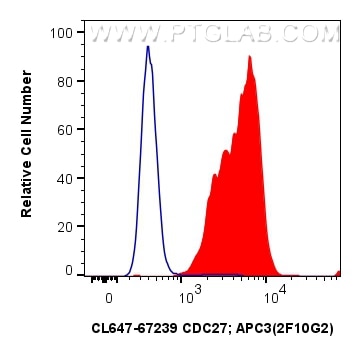Validation Data Gallery
Tested Applications
| Positive FC (Intra) detected in | K-562 cells |
| Positive FC detected in | K-562 cells |
Recommended dilution
| Application | Dilution |
|---|---|
| Flow Cytometry (FC) (INTRA) | FC (INTRA) : 0.40 ug per 10^6 cells in a 100 µl suspension |
| Flow Cytometry (FC) | FC : 0.40 ug per 10^6 cells in a 100 µl suspension |
| It is recommended that this reagent should be titrated in each testing system to obtain optimal results. | |
| Sample-dependent, Check data in validation data gallery. | |
Product Information
CL647-67239 targets CDC27; APC3 in FC (Intra) applications and shows reactivity with Human, Mouse, Rat samples.
| Tested Reactivity | Human, Mouse, Rat |
| Host / Isotype | Mouse / IgG2b |
| Class | Monoclonal |
| Type | Antibody |
| Immunogen |
CatNo: Ag25588 Product name: Recombinant human CDC27; APC3 protein Source: e coli.-derived, PET28a Tag: 6*His Domain: 481-830 aa of BC011656 Sequence: ALCSYNCKEAINILSHLPSHHYNTGWVLCQIGRAYFELSEYMQAERIFSEVRRIENYRVEGMEIYSTTLWHLQKDVALSVLSKDLTDMDKNSPEAWCAAGNCFSLQREHDIAIKFFQRAIQVDPNYAYAYTLLGHEFVLTEELDKALACFRNAIRVNPRHYNAWYGLGMIYYKQEKFSLAEMHFQKALDINPQSSVLLCHIGVVQHALKKSEKALDTLNKAIVIDPKNPLCKFHRASVLFANEKYKSALQELEELKQIVPKESLVYFLIGKVYKKLGQTHLALMNFSWAMDLDPKGANNQIKEAIDKRYLPDDEEPITQEEQIMGTDESQESSMTDADDTQLHAAESDEF 相同性解析による交差性が予測される生物種 |
| Full Name | cell division cycle 27 homolog (S. cerevisiae) |
| Calculated molecular weight | 92 kDa |
| Observed molecular weight | 90-100 kDa |
| GenBank accession number | BC011656 |
| Gene Symbol | CDC27 |
| Gene ID (NCBI) | 996 |
| RRID | AB_2935075 |
| Conjugate | CoraLite® Plus 647 Fluorescent Dye |
| Excitation/Emission maxima wavelengths | 654 nm / 674 nm |
| Form | |
| Form | Liquid |
| Purification Method | Protein A purification |
| UNIPROT ID | P30260 |
| Storage Buffer | PBS with 50% glycerol, 0.05% Proclin300, 0.5% BSA{{ptg:BufferTemp}}7.3 |
| Storage Conditions | Store at -20°C. Avoid exposure to light. Stable for one year after shipment. Aliquoting is unnecessary for -20oC storage. |
Background Information
CDC27/APC3 is a component of the anaphase-promoting complex (APC/cyclosome), which is composed of eight subunits and highly conserved in eukaryotic cells. The APC/cyclosome complex acts as a cell cycle-regulated E3 ubiquitin ligase which mediates ubiquitination and subsequent degradation of target proteins, and lead to the progression control through mitosis and the G1 phase of the cell cycle.

